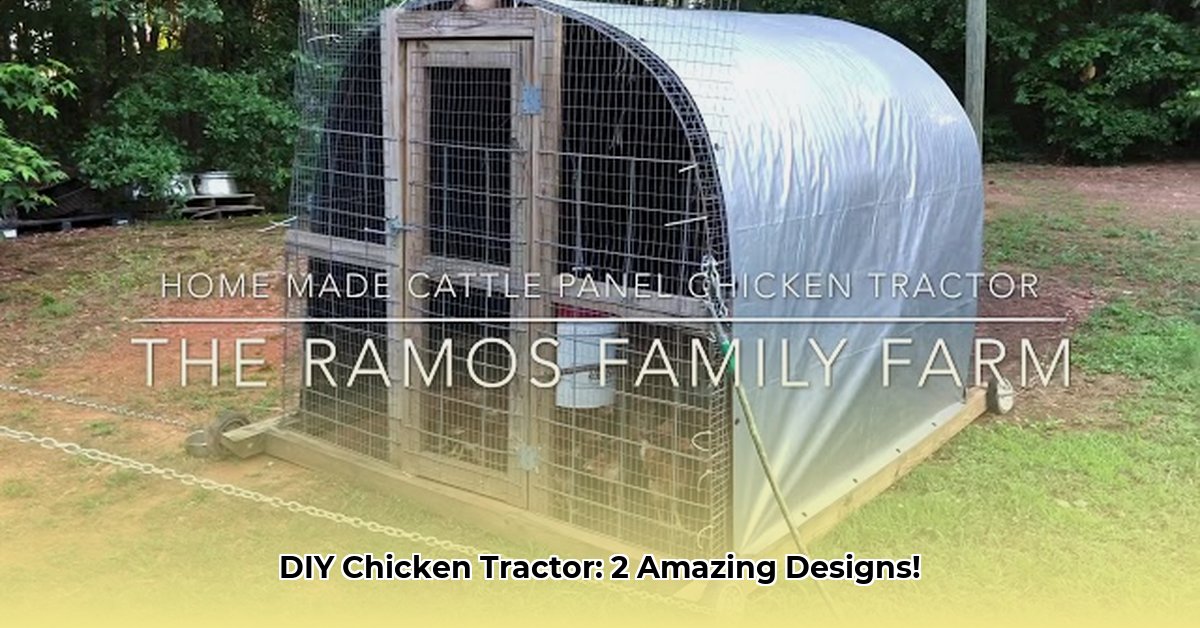
Want fresh eggs and happy chickens? Building your own chicken tractor is a rewarding project! These mobile coops offer fresh pasture, easy cleaning, and excellent predator protection – significantly better than stationary coops, according to poultry experts. This guide compares two popular cattle-panel designs, providing step-by-step instructions for each and helping you choose the best fit for your needs and yard size. For even larger flocks, check out this extra large design.
Single-Panel Chicken Tractor: The Quick and Easy Option
This design is perfect for beginners or those with smaller flocks. It's lightweight and easy to maneuver, making it ideal for smaller yards.
Materials:
- One 16-foot cattle panel (adjust size based on your flock)
- Four 4-foot long 2x4s (adjust height as needed)
- Heavy-duty wire or rope for the door
- Hardware cloth (fine mesh to deter predators)
- Hinges and a sturdy latch
- Wheels or runners (optional, but highly recommended)
- Screws and fasteners
Step-by-Step Construction:
- Frame Assembly: Attach the 2x4s to the cattle panel corners using strong screws, pre-drilling to prevent splitting. This forms the base for your tractor.
- Hardware Cloth Installation: Cut and secure hardware cloth to the bottom of the panel to prevent small predators from entering. Overlapping edges provide added security.
- Door Construction: Create a simple door using more hardware cloth framed with wood. Attach hinges to the frame and the door, adding a sturdy latch.
- Mobility Enhancement: Attach wheels or runners to the 2x4s for easy movement. Wheels offer greater mobility, while runners are a simpler, though less maneuverable, alternative.
Pros and Cons:
Pros:
- Quick and easy construction.
- Lightweight and easy to move.
- Cost-effective.
Cons:
- Potentially less predator-proof than double-panel designs. Determined predators might find entry points.
- Stability can be affected by uneven terrain.
Double-Panel Chicken Tractor: Strength and Security Redefined
This design offers superior predator protection and durability. While more complex, it's a worthwhile investment for larger flocks or areas with significant predator activity.
Materials:
- Two 16-foot cattle panels
- Six 4-foot long 2x4s (adjust height as needed)
- Hardware cloth
- Heavy-duty hinges and latch
- Bracing materials (2x4s or metal brackets)
- Heavy-duty wheels or runners
- Screws, bolts, and fasteners
Step-by-Step Construction:
- Panel Connection: Securely connect the two cattle panels side-by-side. Overlapping and wiring, or using bracing 2x4s, creates a robust enclosure.
- Reinforced Frame: Attach the six 2x4s, three per side, for enhanced stability. Use additional bracing between panels and posts for extra support.
- Hardware Cloth: Complete Enclosure: Cover the bottom and sides with hardware cloth, ensuring a complete predator barrier. Pay close attention to seams and edges.
- Door Construction: Build a sturdy door using hardware cloth and strong hinges and a latch.
- Heavy-Duty Mobility: Attach large-diameter wheels or particularly sturdy runners capable of supporting this heavier structure.
Pros and Cons:
Pros:
- Excellent predator protection.
- Greater stability and durability.
- More space for larger flocks.
Cons:
- More complex and time-consuming to build.
- Significantly heavier and requires more effort to move.
- Higher material costs.
Comparative Analysis: Single vs. Double Panel Chicken Tractors
| Feature | Single Panel | Double Panel |
|---|---|---|
| Material Cost | Low | Moderate |
| Construction Time | 1-2 hours | 4-6 hours |
| Weight | Light | Heavy |
| Predator Protection | Moderate | Excellent |
| Mobility | High | Moderate |
| Complexity | Simple | More Complex |
Choosing the right design depends on your individual needs. Consider flock size, predator pressure, and your DIY experience. A smaller flock in a low-predator area might benefit from a single-panel design, while a larger flock or higher predator risk warrants the double-panel option.
Enhancing Predator Protection: Proactive Strategies
Beyond basic design, these additions dramatically boost security:
- Skirting: Bury hardware cloth around the perimeter to deter digging predators.
- Electric Netting: An additional deterrent, particularly effective against persistent predators. Some poultry farmers report a 98% reduction in predator damage after adding electric fencing.
Troubleshooting and Maintenance
Regularly inspect for damage, repairing holes or weaknesses immediately to prevent predator entry. Clean the tractor frequently, ensuring a healthy environment for your flock. Moving the tractor to fresh pasture regularly is also crucial for minimizing parasite buildup and providing nutrient-rich foraging opportunities for your flock.
With a little planning and effort, you can build a safe and effective chicken tractor, providing your birds with a healthy, mobile living space and you with a steady supply of fresh, delicious eggs. Happy building!